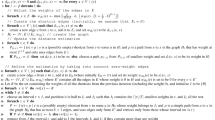Abstract
The (edge) forwarding index of a graph is the minimum, over all possible routings of all the demands, of the maximum load of an edge. This metric is of a great interest since it captures the notion of global congestion in a precise way: the lesser the forwarding-index, the lesser the congestion. In this paper, we study the following design question: Given a number e of edges and a number n of vertices, what is the least congested graph that we can construct? and what forwarding-index can we achieve? Our problem has some distant similarities with the well-known \((\varDelta ,D)\) problem, and we sometimes build upon results obtained on it. The goal of this paper is to study how to build graphs with low forwarding indices and to understand how the number of edges impacts the forwarding index. We answer here these questions for different families of graphs: general graphs, graphs with bounded degree, sparse graphs with a small number of edges by providing constructions, most of them asymptotically optimal. For instance, we provide an asymptotically optimal construction for \((n,n+k)\) cubic graphs - its forwarding index is \(\sim \frac{n^2}{3k} \log _2(k)\). Our results allow to understand how the forwarding-index drops when edges are added to a graph and also to determine what is the best (i.e. least congested) structure with e edges. Doing so, we partially answer the practical problem that initially motivated our work: If an operator wants to power only e links of its network, in order to reduce the energy consumption (or wiring cost) of its networks, what should be those links and what performance can be expected?
This work has been partially supported by ANR project Stint under reference ANR-13-BS02-0007, ANR program Investments for the Future under reference ANR-11-LABX-0031-01, ANR VISE, CNRS-FUNCAP project GAIATO, the associated Inria team AlDyNet, the project ECOS-Sud Chile.
Access this chapter
Tax calculation will be finalised at checkout
Purchases are for personal use only
Similar content being viewed by others
References
Araujo, J., Giroire, F., Liu, Y., Modrzejewski, R., Moulierac, J.: Energy efficient content distribution. In: IEEE International Conference on Communications (ICC 2013), pp. 4233–4238. IEEE (2013)
Baliga, J., Tucker, R., Ayre, R., Hinton, K.W., Sorin, W.: Energy consumption in IP networks. In: 34th European Conference on Optical Communication, ECOC 2008, p. 1 (2008)
Bouabdallah, A., Sotteau, D.: On the edge forwarding index problem for small graphs. Networks 23(4), 249–255 (1993)
Restrepo, J. C. C., Gruber, C. G., Machuca, C. M.: Energy profile aware routing. In: Communications Workshops of IEEE International Conference on Communications (ICC), pp. 1–5 (2009)
Chiaraviglio, L., Mellia, M., Neri, F.: Energy-aware umts core network design. In: The 11th International Symposium on Wireless Personal Multimedia Communications (2008)
Chung, F.R.K., Coffman Jr., E.G., Reiman, M.I., Simon, B.: The forwarding index of communication networks. IEEE Trans. Inf. Theory 33(2), 224–232 (1987)
Giroire, F., Mazauric, D., Moulierac, J., Onfroy, B.: Minimizing routing energy consumption: from theoretical to practical results. In: IEEE/ACM International Conference on Green Computing and Communications (GreenCom 2010), Hangzhou, China, p. 8 (2010)
Giroire, F., Perennes, S., Tahiri, I.: Grid spanners with low forwarding index for energy efficient networks. In: International Network Optimization Conference (INOC), Warsaw, Poland, May 2015
Giroire, F., Pérennes, S., Tahiri, I.: Graphs with optimal forwarding indices: what is the best throughput you can get with a given number of edges? Research Report RR-8752, INRIA Sophia Antipolis, INRIA, June 2015. https://hal.inria.fr/hal-01172725
Heydemann, M.C., Meyer, J.C., Sotteau, D.: On forwarding indices of networks. Discrete Appl. Math. 23(2), 103–123 (1989)
Xu, J.-M., Xu, M.: The forwarding indices of graphs - a survey. xarchiv (2012)
Leighton, T., Rao, S.: Multicommodity max-flow min-cut theorems and their use in designing approximation algorithms. J. ACM 46(6), 787–832 (1999)
Linial, N., London, E., Rabinovich, Y.: The geometry of graphs and some of its algorithmic applications. Combinatorica 15, 577–591 (1994)
Manoussakis, Y., Tuza, Z.: The forwarding index of directed networks. Discrete Appl. Math. 68(3), 279–291 (1996). http://www.sciencedirect.com/science/article/pii/0166218X9500072Y
Meringer, M.: Small cubic graphs, flinders Univ projet. http://www.flinders.edu.au/science_engineering/csem/research/programs/flinders-hamiltonian-cycle-project/graph-database.cfm
Miller, M., Širán, J.: Moore graphs and beyond: a survey of the degree/diameter problem. Electron. J. Comb. 61, 1–63 (2005)
Mohar, B.: Some applications of laplace eigenvalues of graphs. In: Hahn, G., Sabidussi, G. (eds.) Graph Symmetry. NATO ASI Series, vol. 497, pp. 225–275. Springer, Amsterdam (1997)
Orlowski, S., Wessäly, R., Pióro, M., Tomaszewski, A.: Sndlib 1.0—survivable network design library. Networks 55(3), 276–286 (2010)
Shahrokhi, F., Matula, D.W.: The maximum concurrent flow problem. J. ACM 37(2), 318–334 (1990). http://doi.acm.org/10.1145/77600.77620
Sinclair, A.: Improved bounds for mixing rates of markov chains and multicommodity flow. Comb. Probab. Comput. 1, 351–370 (1992)
Solé, P.: Expanding and forwarding. Discrete Appl. Math. 58(1), 67–78 (1995)
Tassiulas, L., Ephremides, A.: Stability properties of constrained queueing systems and scheduling policies for maximum throughput in multihop radio networks. IEEE Trans. Autom. Control 37(12), 1936–1948 (1992)
de la Vega, W.F., Manoussakis, Y.: The forwarding index of communication networks with given connectivity. Discrete Appl. Math. 37–38, 147–155 (1992)
de la Vega, F., Gordones, L.M.: The forwarding indices of random graphs. Random Struct. Algorithms 3(1), 107–116 (1992)
Xu, J.M., Xu, M.: The forwarding indices of graphs - a survey. CoRR abs/1204.2604 (2012)
Author information
Authors and Affiliations
Corresponding author
Editor information
Editors and Affiliations
Rights and permissions
Copyright information
© 2016 Springer International Publishing Switzerland
About this paper
Cite this paper
Giroire, F., Pérennes, S., Tahiri, I. (2016). How to Design Graphs with Low Forwarding Index and Limited Number of Edges. In: Lipták, Z., Smyth, W. (eds) Combinatorial Algorithms. IWOCA 2015. Lecture Notes in Computer Science(), vol 9538. Springer, Cham. https://doi.org/10.1007/978-3-319-29516-9_19
Download citation
DOI: https://doi.org/10.1007/978-3-319-29516-9_19
Published:
Publisher Name: Springer, Cham
Print ISBN: 978-3-319-29515-2
Online ISBN: 978-3-319-29516-9
eBook Packages: Computer ScienceComputer Science (R0)




